Every week without fail we see multiple comments, quotes or exasperated exclamations along these lines;
“BUGGER THIS; I’M GOING OFF GRID..!”
It’s a natural reaction to a nasty power bill and expresses a desire to be independent and free of obligation. But becoming your own power company is expensive, fraught with risk and really doesn’t make sense.
Living The Dream
Some people think “going off grid” is a great idea. As an off-grid installer for 15 years, I can assure you it’s not all beer and skittles.
Many years ago, an electrician mate of mine had a dispute with SAPN and decided he could live in the city without that dirty rotten grid electricity. He was going to rely on solar power and his own wits, which were considerable as he was an experienced electrician with solar and battery endorsements.
In those days, 24 flooded lead-acid batteries weighed a tonne and a half and needed regular distilled water replenishments. Sourcing them as ex-Telecom phone exchange batteries did make some economic sense, though.
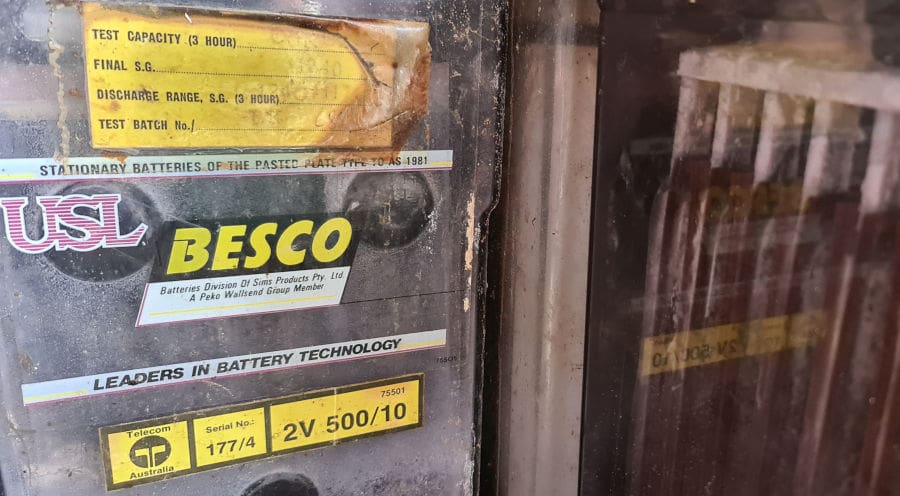
These flooded lead-acid batteries have seen better days.
Solar was still well over $5/watt, meaning his array was modest but he didn’t have a generator for backup because the neighbours would lynch him if they had to endure a genny wailing all night.
His key to system reliability was the red switch at the front door, it shut down everything except the fridge and the porch light. Why? well when “someone” left a hair curling iron on over the weekend, that was enough to fully deplete his battery.
Imagine the deflated feeling you get when your car won’t start because the battery is flat… but it’s your house so it’s even worse.
Everyone Needs Backup
There’s really no escaping the fact that reliability relies on redundancy. When you zoom out to the scale of Australia’s main grid, there’s dozens of generators making up the supply of electricity, but some of them aren’t doing much work. Rather, they’re operated as a live insurance policy mandated by the Australian Energy Market Operator.
Effectively, these generators are sitting there idling, ready to go when some transmission assets blow down or the Calide coal burner blows up; again and again.
In the old days, this extra capacity was called “spinning reserve”, and it involved keeping coal fires burning with steam on hand, ready to throttle on at a moment’s notice.
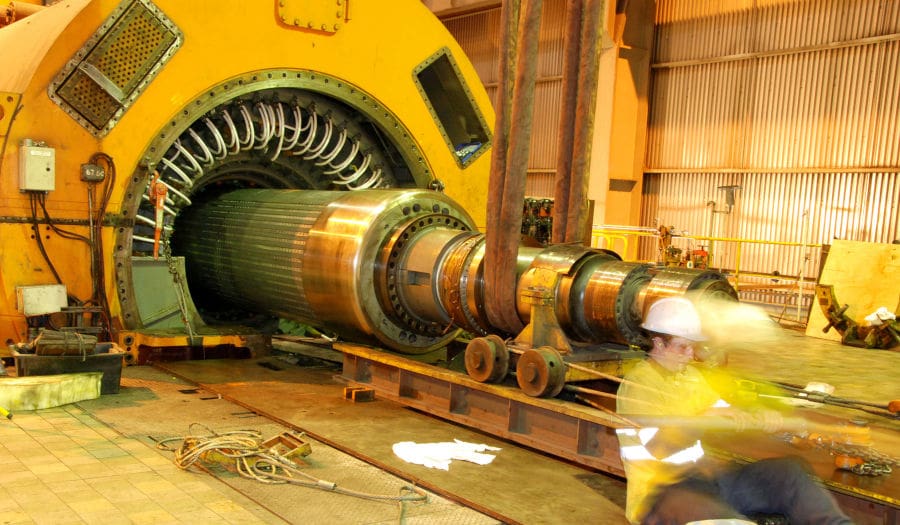
Coal-fired steam at Lidell kept this rotor spinning at 3000rpm. Weighing literally tonnes, its inertia kept grid frequency under control.
Under the current system, there’s a market for what’s technically called Frequency Control and Ancilliary Services (FCAS), and generators will be paid for both the amount they have available and whether they can deliver it in under six seconds or under six minutes.
These FCAS services are faster and more accurate using grid-scale batteries. Without all the machinery and mining, they’re cheaper to run, and they collectively save us millions of dollars.
You Need Backup Too
Even the most modest user will find there’s a long week in winter (or a cyclone) when a succession of cloudy days hobbles solar input. Cold weather also means water and space heating demands are higher.
Your system might be designed to furnish 10kWh per day, with 20kWh of battery for two days of autonomy. On cloudy day 3, you’ll need backup, or you’ll find your freezer thaws and your battery warranty is rendered void.
In a remote area, it would be a diesel generator, but the grid is quieter, stronger, better quality and 99.998% reliable by law.
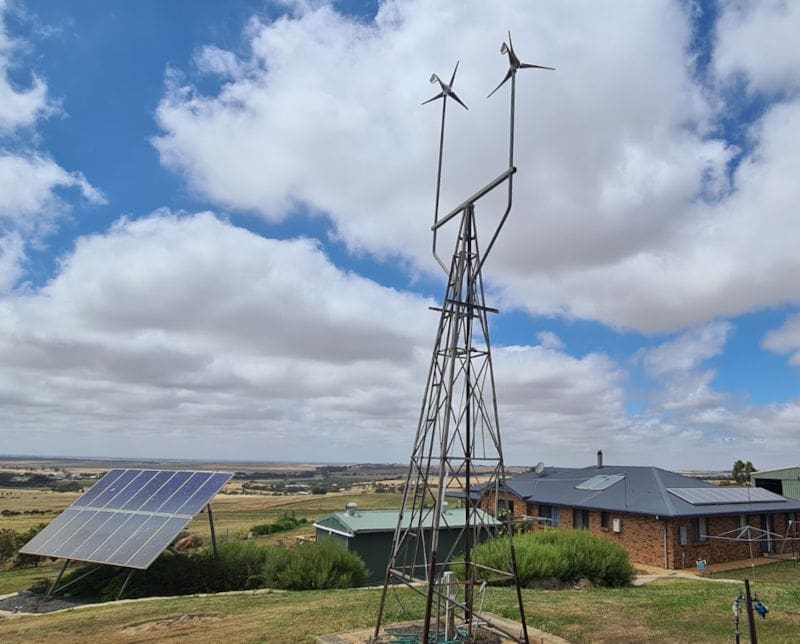
A whirlygig might be cute but if you find a viable wind generation site, it won’t be a nice place to live, nor will any installer want to deal with integration.
The Grid Is Cheaper
Seasoned installers will explain remote area power is not free. It’s worth setting up an automatic savings plan, putting aside what you would normally pay for an electricity bill to give you a budget for the rainy day you’ll need to call for service or replace the batteries.
In terms of generators, maybe you can get away with a petrol one — the cheap unit with a pull string that powers your camping trip might benefit from being used more regularly.
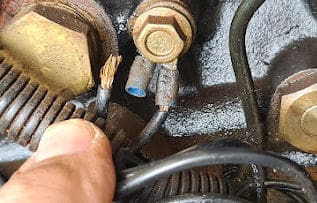
Generators vibrate, rattle & fall apart, becoming unreliable as they age
However, a proper 15kVa 3-cylinder diesel genny is a $15,000 capital cost. It’ll need a cranking battery replaced every few years and you’ll have to haul fuel in jerry cans or pay for bulk delivery.
A professional service from a mobile mechanic, with filters and oil included, will almost certainly cost more than a daily access charge for the mains power you already have.
The Grid Makes Your System Cheaper
Not everyone realises how difficult it is to start an electric motor. However, your fridge, heat pump, rainwater pump, air compressor, or air conditioner can easily demand six to eight times its running current at the instant you turn it on.
For example, a 500w rainwater pump will draw 2.1 amps running your shower, but nearly 17 amps at startup.
Your mains supply is strong; it will deliver 6000 amps to blow a service fuse in a snap. However, a 5kW lightweight hybrid inverter that only manages 27 amps just isn’t that stiff. It may manage during a blackout, but if there are already a few lights turned on, it will struggle or just shut down.
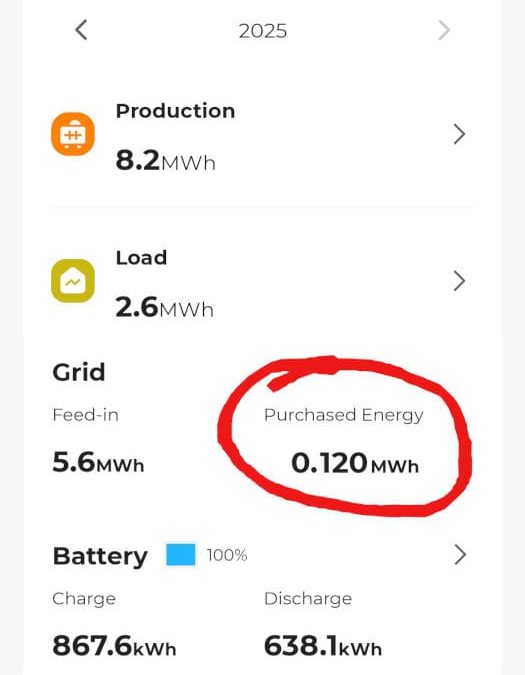
This 20kW solar, 12.8kWh battery, 10kW hybrid inverter system provides gutsy energy independence, but it still needs a little reinforcement from the grid.
If you want an off-grid system to meet this surge load, the rule of thumb says it needs to be about 4 times larger and more expensive than the modest hybrid that will otherwise provide the vast bulk of your energy.
And the bonus of being grid-connected is you can pick up a few credits for exporting energy and helping your neighbours.
You Still Want To Treat The Grid With Contempt?
There are good reasons that Fronius, Enphase and Tesla don’t support use of their lightweight hybrids for remote areas. They’re simply not designed for it, and Tesla found out the hard way when they tried with Powerwall 2.
Some brands of high-voltage, high-frequency, transformerless inverters claim they’re good for off-grid. Some say they’ll auto-start a generator too — but they can’t run an exercise program, or start under high load, or lockout overnight.
I think these cheap inverter companies are just adorable in their optimism. As an installer, I wouldn’t risk being the one on the hook for warranty under Australian Consumer Law.
The clue is in the name for these lightweight grid hybrid machines.
In a nutshell, you don’t want a hybrid with 20% extra capacity for surge loads when a proper grid-forming inverter offers 140%.
If you must thumb your nose at the networks, you need hardware that’s designed for the work and a system specified by an experienced operator to meet the loads.
It could be a large three-phase workshop or resort accommodation, perhaps using an existing 20a rural supply to help it along, with a generator for even more redundancy. Anything is possible these days, and if the grid is 200,000 dollars distant, it’s often economical too.
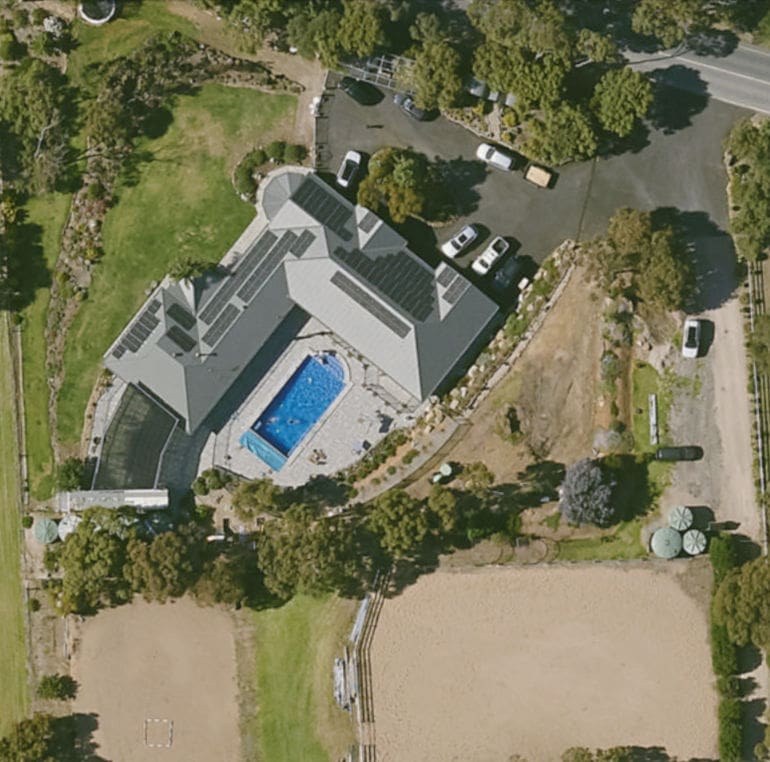
Maximum capacity on a single phase supply was 10kW of solar here. Another 30kW of off grid system with 56kWh of battery augments the supply for the princely sum of $150,000
Don’t Go Off-Grid To ‘Stick It To The Man’
I have installed “off grid” power in the suburban fringe for people who in their own words “simply don’t trust” the authorities or anyone else. Incidentally, they were the only customers who ever changed the WiFi password after I’d set up the system and left the premises.
The technology to do it properly is not a cheap mass-market product. In this particular case they were committed to a wood stove for home heating and hot water boosting. With the grid isolated, there wasn’t enough solar capacity to avoid buying firewood.
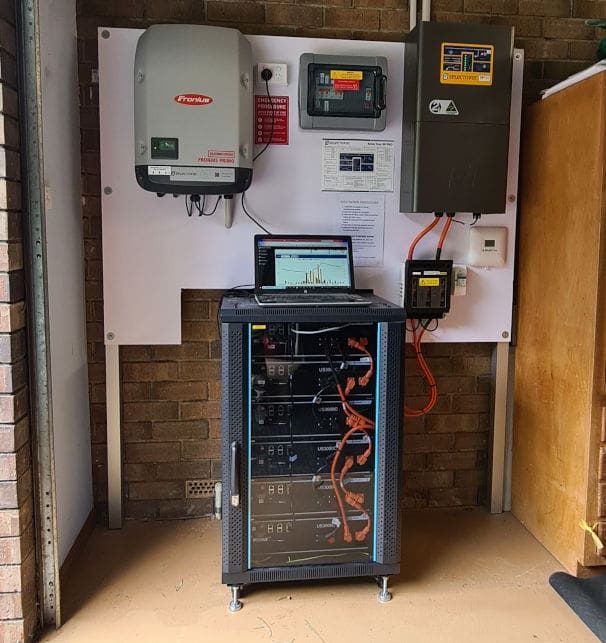
5kW Selectronic SpPro will provide 12kW of surge capacity, so this grid hybrid means business.
The reality is that most Australian houses are horribly inefficient and they’ll need a vast solar power system to meet their needs. If you want independence, then improve the house, insulate everywhere, get off gas; and use a grid hybrid solar and battery to minimise your bill.
Going off-grid just to stick it to the man will be expensive and a waste of resources that we would all be better off sharing via the electricity network.
For more on the reasons why off-grid is generally not the way to go (and the four exceptions in which it might be a good idea), read our explainer.


 RSS - Posts
RSS - Posts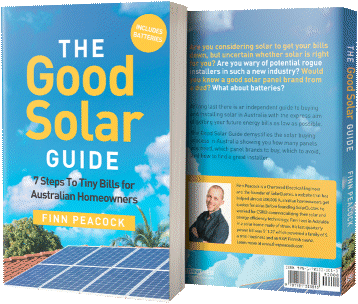


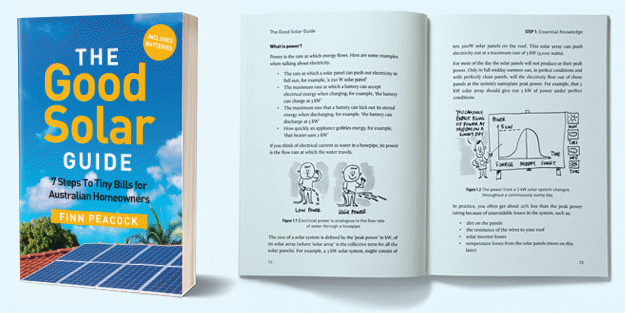
I agree with pretty much everything you’ve said Anthony, but here’s my fear point.
Today I pay about $1.50 per day to access the grid. My fear is that when I put a battery in and avoid paying usage charges, along with all the other “early adopters” on Solar Quotes then the retailers in this market will modify the daily charge so they still get their $100-$150 per month from each participant.
If I get to the point where Im asked to contribute $1800 per year to just connect then I’ll likely disconnect.
In your article you talk about a home as an all or nothing scenario, when a hair curler can cause your fridge to stop cooling then something is wrong. We just need to set up a house to locally load shed. That is, if your automation controller can see the forward forecasts and know it has to last 4 days before seeing significant solar input then simply don’t let the hair curler work. Put the pool pump into hibernation so that the fridge can last
In WA, if power goes past your property, you cope the daily charge even if not connected. Just like town water is ATM .
In WA even though power goes past your door, you can avoid paying if you have your meter removed by Western Power (Perth)
Our supply charge is $1.867690 at two regional locations. One was about to go up to $2.05 per day.
As you say, there will be a point we’re off grid does make economic and practical sense.
I think that point might be reached sooner in regional areas with higher charges, as well as the lower FIT we are all experiencing.
Remember when 2 kWhr feed in during the day paid for 1kWhr from the grid at night? Who needed a battery then!
When you consider that solarquotes is owned by Origin Energy then you are right to be sceptical about this article. It is very much in the interests of solarquotes that you do not disconnect from the grid.
Hi Rohan,
I’ll not take it personally but thanks for missing the point.
A decent compliant off grid system from a reliable installer would cost $85,000 to give you 20kWh/day… and you’ll still have to haul diesel from time to time.
You’ll get the vast bulk of the energy you need, quietly, from a grid connect solar power system that costs $20,000.
Either way SolarQuotes gets paid for delivering you the customer a decent installer.
If Origin want to court you as a retailer, they’ll need to create an attractive offer in the market.
To be frank they’ll want to, once Eraring stops burning coal they’ll need people on VPPs.
In fact the whole country will need to act together because societies don’t flourish without decency & cooperation.
My secret fear is that the several HV pylon storm flattenings we’ve had below +1.6°C will escalate alarmingly above +2°C, coming soon enough. That means grid fragmentation, which nuke power stations won’t fix. Competing disaster recovery will by then bleed resources in time of need.
Ample regional & street-local grid-scale batteries can provide high levels of climate / disaster resilience – but *only* so long as rooftop solar feeds surplus back in. At that time, FiT will recover a bit – maybe even enough to help replace blown off rooftop panels, as insurance may be hard to find.
Local grids will optimally go underground, or some of the resilience will be lost. Our pollies can be relied on to do the right thing – after all alternatives have been exhausted.
Rohan, I’ve been off-grid for a year, through need. Would you like to follow suit? The investment, the equipment, and the effort to maintain might surprise. There’s no direct FiT for payback and climate/social benefit, either.
One way or another they will get their profit. No FIT and the daily charge will keep going up to minimise losses and you can bet your last dollar you will be charged if a power line goes by your dwelling even if you are off grid. We just have to accept that it’s a no win scenario.
In WA you get hit with a electrical service charge , even if you are not connected to the grid so may as well stay connected for cheap backup power for your suburban offgrid.
A global daily electricity service charge will probably end up being implemented on the east coast sooner than later . Especially if people keep disconnecting to go offgrid in suburbs.
If you are not connected to the grid you won’t have an electricity account so how will they be able to charge you with a service charge?
im guessing the same way that a council can charge you rates when all you have is an empty block without a letterbox……
in WA I assume they cant charge it if it isnt outside your property. How close does it have to be to a house to get you charged? On a big farm for example it might be right on the fence line and still hundreds of $k away from your home…..that would add insult to injury I would think….
Andy
Who charges the fee if you’re not connected to a retailer?
For WA you only have Horizon Power or Synergy to select from right? Or are those Perth versus rest of WA? For many of the eastern states you have more than a score of retailers to choose from.
Im of the view that the grid is great and we should all contribute to it.
The moment the retailers see us a sheep to be shorn they need to remember that technology keeps evolving and a fully automated house where you have granular control over all electrical using components in the house is just around the corner, as is the software to allow Joe User to make informed but automated decisions.
Off Grid in the past has been about replacing the grid with your own micro version of it, individual item Demand control is more important in the future and will enable off grid to be far more achievable.
I also note that my old split system aircon of about 10yrs age did need significant extra start up current and more ongoing use current. New systems which were selected for efficiency rather than cost, seem to need far less startup current and far less ongoing current. As these things become important to consumers I believe we will all be in a better position to ultimately choose tgo it alone
Well said! I think solar attracts a lot of survivalist/self-sufficiency fans, a bit like that period during the oil crisis in the 1970s, when everybody watched The Good Life and dreamed of becoming self-sufficient from the entire world. The grid is a marvel of modern collective life, those economies of scale available to every homeowner.
P.S Can we get the comments size increased…I don’t believe I’m flogging that proverbial dead horse… but feel quite constrained in what I can say
You and me both Andy,
I’ll pass on the feedback 😉
Anthony, you’ve clearly been there – that’s my lived experience too. With 27 kW of top tier panels & 46 kWh of batteries it was $72k after $8k rebates. Skimp a bit on both for a budget $50k – $60k minimal system, I figure. The x4 scaling is “the” benchmark for off-grid, I have to agree. That can pretty much eliminate generator starts. It only needs to supply average demand, not peaks, though, so a 3 kW Honda does it here.
Here it’s incessant summer overcast, mostly clear sky in winter, but 5% yield is only 1.3 kW, so a big battery is good. And rain = 0% yield.
Tipping panels up 40° to catch winter sun, & on the west too, helps.
A new 6-star build + wood heater helps a lot, but aircons don’t draw much – good in spring/autumn.
Two 8 kVA battery inverters + two 6 kW PV inverters are stiff enough, but the ¾ ton lathe’s 1.5 kW induction motor occasionally throws the 20A breaker, with gearbox & massive chuck inertia boosting stall current duration.
Yup, grid > $200k distant here. 😉
VFD could help the startup current for the lathe?
(most of them have timers for soft start)
Yup, but at considerable cost. There’s one built into the Grundfos water supply pump, and that wasn’t cheap.
I’m thinking of doing a drive conversion on the milling machine, as wrangling great fat stiff v-belts, through a slot, at head height, for a speed change, is like fighting a muscly Medusa. It’s placed right beside the house 48v battery bank, in case I decide to go with DC motors & control. My brother has just begun an EV conversion on a farm vehicle, using Chinese BLDC motor & control. OK, that’s just a 3 phase motor with DC-AC controller. Drop his 10 kW motor to the 5 kW size, and there’s just the motor adaptor plate and pulley fitting.
Something similar on the lathe would give much better speed range than is possible with the existing induction motor, but with tungsten carbide tooling, that’s less of an issue than on the mill.
The lathe is on a 10A GPO, but the 15A GPO also only has a 20A breaker, unfortunately. Maybe a SSR with zero-crossing switching will gentle it OK.
But it is possible: https://www.sustainablehouse.com.au/
We all like to dream of sticking it to the man. It comes from years of being used as a captive cash cow while big business paid peanuts for power.
With solar and battery we are still a captive cash cow, albeit on a much smaller scale, with the grid access charge.
But i rarely have to spring for any actual electricity from the man, so at least there is that.
We are on our way to well over $1,000/year for grid connection charges alone. It’s not such a silly sentiment to wonder if off-grid makes sense they way the grid costs are going.
Listen to this and take heed! You will not be sticking it to the man but to yourself if you go off grid voluntarily. I moved to a new property 10 years ago and found myself off grid simply because there was no power to the property, and the cost of bringing it in was $40,000, which I refused to pay. But soon I learned that the number of installers able and willing to do off grid work was in the low dingle digits, like ONE! Fortunately I got my system in, but it cost me close to $40,000 anyway.
I certainly enjoyed the freedom from power bills and steadily rising charges. But, as Anthony says, there is always that “long week” (or two) in winter when you watch your battery reserve falling toward zero and worry whether you’ll make it through to the next sunshine, and even if you do, the sun is at its lowest and weakest then. Even if your daily usage is only 3 kwh, there are only so many things you can unplug. You’re like the man in a sinking boat with no more ballast to throw overboard.
Had my pool heater (heat pump) service guy around today. The breaker kept tripping. He found that a “soft start” capacitor had deteriorated and so the start-up current had increased. Not sure if other motor devices like air conditioners have this feature but it seems like a good idea for solar/battery systems.
Hi Michael,
Any single phase electric supply has peaks 180° apart, so a motor needs a starting capacitor and/or switchgear to create some phase shift and give it starting torque.
If the capacitor(s) fail it either wont start or will run slow and overheat.
Whereas 3 phase, with pulses 120° apart simply has a roataing magnetic field and doesn’t need anything tricky to get it moving.
Both types will draw 6 to 8 times thier running current when starting.
Newer technology appliances, such as those you see with a “inverter” label on them, have a layer of power electronics to operate at variable frequency/speed according to demand.
They’re referred to as “soft start” because they can ramp up slowly & run at higher overall speed than 2800rpm allowed by fixed 50Hz grid frequency.
Pool pumps & air cons are increasingly likely to be variable speed, and so they impose less peak demand but smaller motors are more likely simple direct on line starting.
While I agree that at the moment going off-grid in n suburbia is not sensible currently, the day when it is viable is coming closer.
Running solar and 20kw battery may not save you from that run of overcast days. But you now, or soon will have, the option of taking your EV down to the public charging station, filling up and then plugging your home into your car or recharging your home battery.
While you only want to do this every few months or so, there is no need for generators or other backup systems
Yup, who needs a backup generator when you have a giant battery on wheels that can bring 3 or 4 days worth of power to your house during those infrequent solar drought events.
Hi Jojo,
I know it’s a concept people are already using with V2L inverters in cars to act as a generator.
You may find 75c/kWh at a fast charger, plus time and comversion losses, is a little difficult to stomach if it becomes a regular occurrence.
I’m a tiny man, in a tiny country, with a tiny house, far away from you, way up in the northern hemisphere.
It was my dream since I was a kid to not to have every aspect of my existence at someone else’s discretion.
And boy it’s that a fight!
Some just won’t let go. I work hard from dusk to dawn so some can have big houses and expensive vacations.
Thing is that if the grid blows my fridge or my house, it is still I who has to jump thru hoops and loops and courts or just take one for the utility team.
I’m not joking. It was bad before the solar boom, it is just as bad now. Years of me plotting and logging grid parameters showed me it is just a liability, not even a worthy backup.
And the relationships between Joes and Companies are always one-sided. No equity. None.
If I suffer damages, I’m told to go love myself. If I miss a bill, I get visits from collectors.
I’ve cut the cord and took it upon myself.
I am a free man.
Modern appliances and pumps don’t have high surge demand on start up. That’s old school stuff. Inverter tech helps and while soft starting pumps are common.
Smart load control and automation is even easier nowadays.
I ran off-grid at our last home for a few years and the EV replaced our generator for the few occasions we needed supplemental battery charging.
The costs of decent off-grid systems have declined a lot, so if the utility daily supply fee keeps going up (and it’s heading beyond $1k/year before you’ve even imported any energy) then it’s not as silly as is being made out. In some areas the utilities are becoming uneconomical.
Interesting your mention of a legal requirement that the grid provide 99.998% reliability struck a chord with me. I just checked our battery system a Powerwall 2 and in 37,920 hours of operation we have had a little over 48 hours of grid out time as a result of 103 supply interruptions resulting in an availability of 99.874%.
What would our recourse be in this situation. We have not lost any appliances or indeed any foodstuffs but our neighbors are in a much worse position with damaged appliances plus food losses which are covered in the event of long er outages.
We are in Perth but I would assume the power quality requirement would be similar or does anyone know better?
I wouldn’t go fully off-grid but my future plan once the 44cent feed-in ends is a system sized to essentially be capable of running off-grid indefinitely but keep the grid connection and use the feed-in from excess capacity just to pay off the connection fee.
Any ROI can come from not paying power bills so i only care about feed-in as far as zeroing out the cost of keeping the grid connection for backup.
Most likely you will be able to only partially offset the connection fee. We only get 4c a kw and we are limited to 5kw feed in. In peak summer we can go close, or even slightly exceed feeding the 30kwh needed to pay the $1.20 daily fee, but generally 1/2 to 3/4 is as good as we do the rest of the year.
I take the view that one day the technology and price will reach a sweet point point where going off grid makes sense. But that isn’t going to be for a little while yet!
16c feed-in currently last i checked here.
And only limits on the feed-in is getting connected through ergon.
They list 1-10kw and 30kw+ as standard connections though 11-29kw needs to be a “negotiated connection” “last checked last year”
The system i sized up when i was looking into dropping the 44cent was 10-15kw inverter/s with 32kw DC batteries and 20kw of panels. for approx 50k starting price
That is far better than what most of get!
As an Earthling it really offends me that so many people are habitually attached to their air-conditioning and just because you have solar panels it doesn’t you can keep on consuming like drunken sailors.
Hi Jeff,
You’re absolutely right.
Efficiency really is king but sadly Australians don’t build houses worth a pinch of sh!t and so they’re often uninhabitable without air con.
Proof of this was the heatwave *preceeding* Victoria’s black Saturday fires had completely filled the morgues.
Hence heatwave warnings are now much more prevalent in the media.
Aircon problem: In 2019 the ABC reported:
`There are 3 billion people living in regions of the world where air
conditioning is needed more than 300 days a year, and as the world’s climate
warms, that number is getting bigger and bigger.
The IEA estimates there could be an extra 4 billion air conditioners around the world by mid-century, which alone could push up the world’s temperature by more than half a degree. “We expect up to 4,000 terawatt hours, which is 10 times the Australian electricity system, [in] additional electricity demand, [which] can potentially emerge only from air conditioning,”‘
https://www.abc.net.au/news/2019-01-12/rising-demand-for-air-conditioning-alarms-climate-change-experts/10710956
Scary numbers, if real – BUT if all solar powered, the problem (CO₂) vanishes.
If 100% photon powered, no amount of consumption is excessive, as it’s zero emissions, and even cools the roof! I managed 42.6 kWh 16 days ago, but will seek to increase that, for planetary good.
I have a friend who’s an air conditioning engineer and actually one of the things that most annoys him is people using them only sporadically. He says they’re there to ‘condition’ the air, but Australians use them as heaters and coolers. Which both stresses the units more and often ends up using more energy, particularly in homes with good thermal mass.
I tested it at my place, which has thick double-brick walls. I ran the splits 24 hours a day for a few weeks, and compared my electricity consumption with weeks (in winter) where we only turned the splits on in the morning and evenings to heat our living areas. We actually used less energy with the units running 24 hours a day. Technically I think they call it pre-conditioning, and energy efficiency experts advocate for the approach, particularly for those with solar.
Jeff
I struggle with your rationale, If I already have airconditioning and I can completely run it for absolutely no impact to the grid and only use 100% renewables to run it then why cant i consume like a drunken sailor??? If the FIT that the current retailers offer is basically 0 or in fact at times even negative if my retailer reflects the wholesale market then I personally see no issue at all with doing this if it makes my life better and affects no one else negatively?
The fact that there is still not yet any significant pumped hydro schemes in operation to absorb and store excess solar production in the middle of the day is not at all my personal fault….just those previous idiots in power that still want to argue that climate change isn’t really a thing…. If there was pumped hydro then I would get a reasonable FiT in teh middle of the day and I’d have to determine the lost opportunity costs for running my Aircon.
Andy
I agree. I didn’t spend a fortune to prop up the grid. That is not my responsibility.
I’m producing the power and will use it how I see fit.
Like you, if I’m going to get 0c for my power then I ensure maximum consumption and ensure my comfort. I’m addition we are paying $500+ a year connection fee for not using the grid, more than enough to contribute, but we’ve gone from “gold plating” the grid it seems to bring to platinum coating it because they simply are not doing a good job in making it suitable for the needs.
When you’re on renewables like solar and, better yet, off the grid, the ACs (aka heat pumps) are THE go-to means of keeping the house habitable.
Clean, safe, economical, efficient, echological.
In the peak of summer, when the sun blasts the PV array at full might, the batteries are full and the AC keeps us cool and even alive with ZERO impact on the grids, bills and environment. This is THE way.
Also, modern units are very friendly with the electricity source (inverter or grid) by implementing the much more efficient inverter technology. They are quieter too.
And, in the winter, they are magic. The coldest of colds is when the sky is clear so there is spare sunshine to pump up the house with some extra heat to offset the other heating means.
If you have PVs, some solar heat collectors like vacuum tube absorbers are a very good idea, further reducing costs and reliance on fossils and fossil mafia.
I have 7.5kwh of battery, 2kwp of PV and no “range anxiety” WHATSOEVER.
Thank you, Anthony, for another well-reasoned article with both theoretical and practical references. May I please ask for your thoughts on the following.
(1) Given the current pricing structures, I’d be interested to know at what rate might the Daily Service Availability tariff become too high to support reasonably priced household grid connection. Electricity fed in by solar panels at the current FiT don’t tend to cover this cost and even VPP services seem to take as much as they give if you happen to be a battery owner.
(2) Is it even possible to go off-grid in NSW and cease payment of the Daily Service Availability tariff? Even if request no garbage collection at my property, the local council still charge for availability.
Many thanks for all you and the team at Solar Quotes do to make the complicated topic of electricity simple for us “joe-average” consumers.
Kind regards
Andrew
Thanks Andrew,
We do try to be helpful.
The question of how much the fixed costs need to climb before we see a real death spiral in grid connections is a length of string really.
There’s too many variables to calculate but if we’re but careful it will be yet another case of the haves & have nots.
If electricity to run a fridge becomes too expensive, not having one will be horrendous when you have to buy food daily in small quantities and/or get sick eating stuff that’s gone off.
I think if you have a meter removed you’ll avoid the service charges.
However I look at it like the sewer, or rubbish collection.
If this services were private user pays scenario then people would dump stuff on the streets or pile it in their yard.
It’s bad enough now with people dumping loads of crap on back country roads.